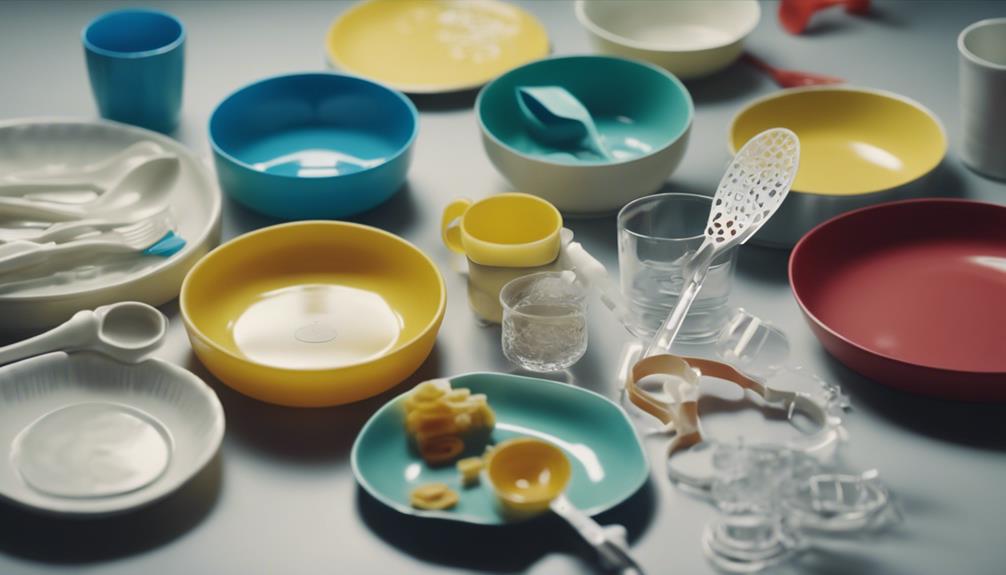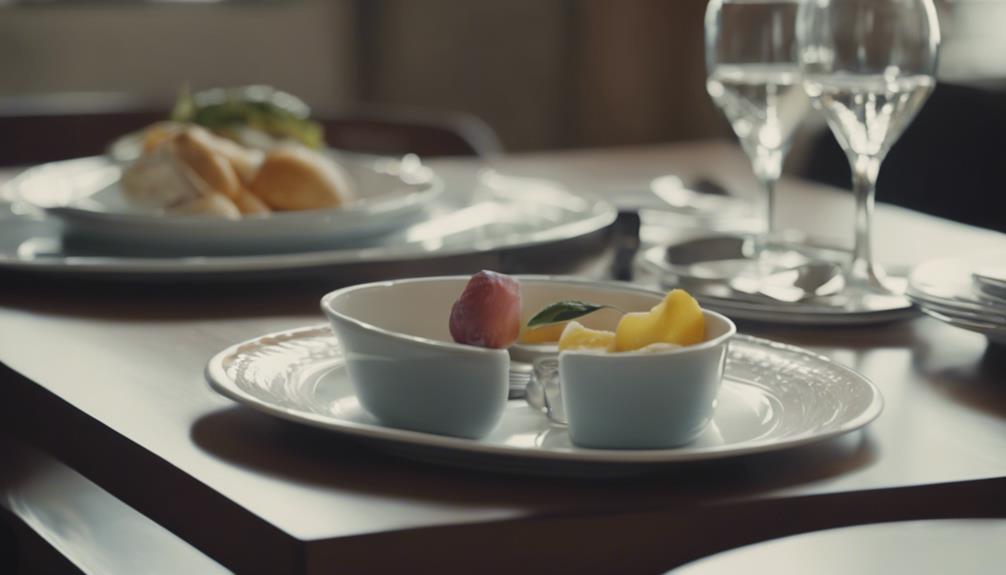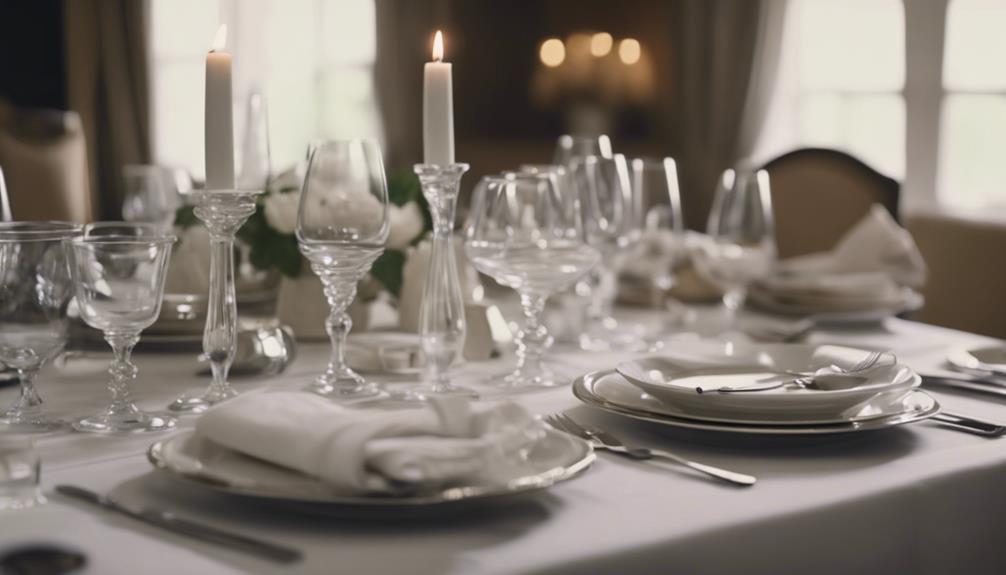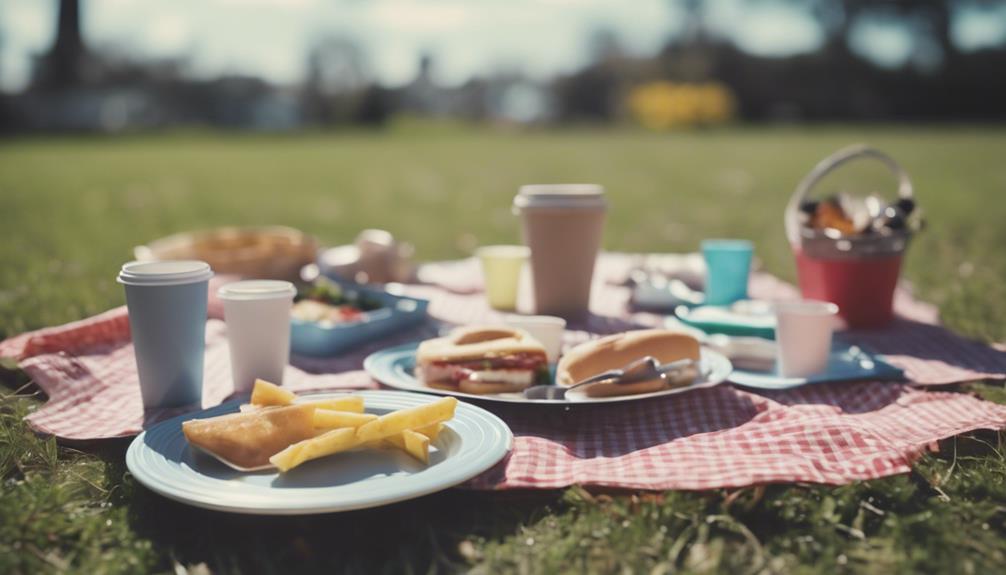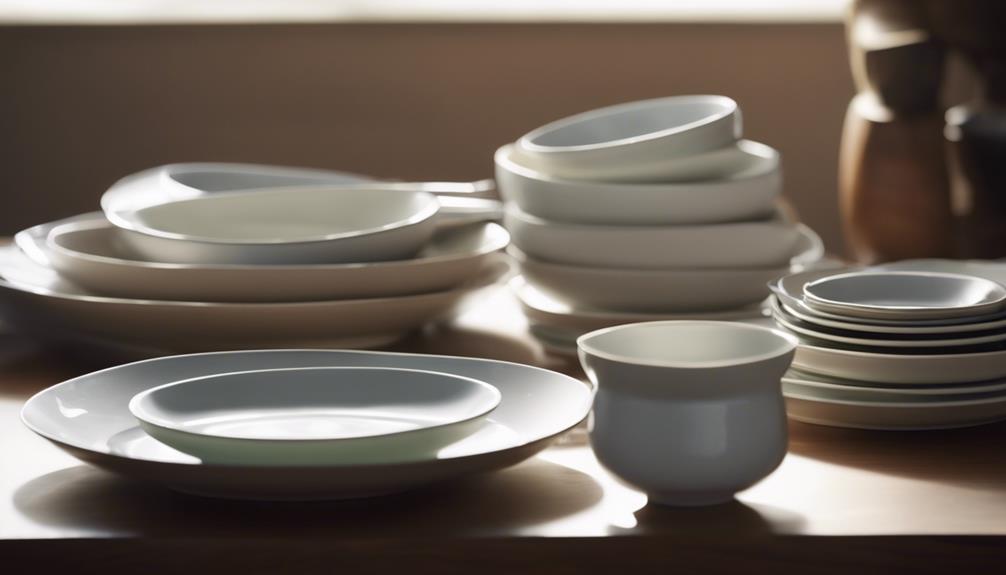Plastic tableware can pose risks as chemicals such as BPA, phthalates, and melamine can leach into food, potentially affecting health. Choose safer alternatives like glass, ceramic, or stainless steel to lower these risks. These options decrease exposure to harmful substances, supporting overall well-being. By making educated choices about your tableware, you are putting safety first in your everyday routine.
Key Takeaways
- Plastic tableware can contain harmful chemicals like BPA and phthalates.
- Chemicals can leach into food, especially with hot substances.
- Safer alternatives like glass or stainless steel reduce health risks.
- Prolonged use of plastic tableware may impact hormonal balance.
- Choosing BPA-free options minimizes health hazards.
Potential Risks of Plastic Tableware
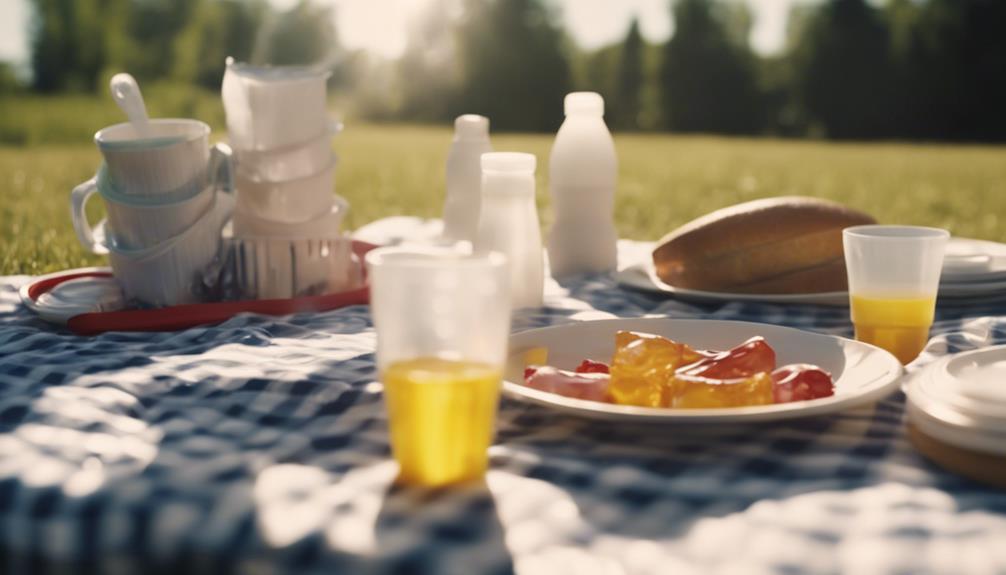
When considering the safety of plastic tableware, understanding the potential risks associated with its use is essential. Plastic plates, commonly used in households, can harbor harmful chemicals such as BPA, phthalates, and melamine. These chemicals have the potential to leach into your food, especially when in contact with hot or acidic substances. Prolonged exposure to these harmful compounds from plastic tableware can result in adverse health effects, including risks to hormonal balance and kidney function.
Studies have even linked exposure to phthalates with an increased likelihood of developing cardiovascular diseases. Hence, it's important to avoid using plastic tableware, particularly when dealing with hot foods or beverages that can accelerate the release of toxins from the plastic material. Opting for safer alternatives like glass, ceramic, stainless steel, or melamine-free options can significantly lessen the health risks associated with plastic tableware usage. Making informed choices about the tableware you use can help safeguard your well-being in the long run.
Common Harmful Chemicals in Tableware
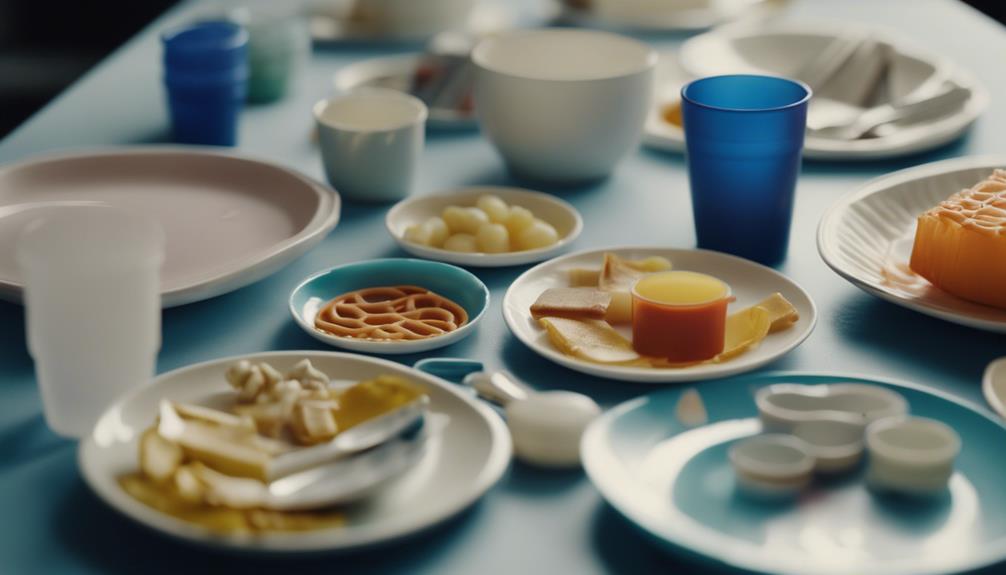
Common harmful chemicals found in plastic tableware include melamine, polystyrene, phthalates, and Bisphenol A (BPA). When exposed to hot or acidic foods, these chemicals can seep into your meals, potentially causing health concerns.
Opting for safer alternatives can help minimize your exposure to these harmful substances and reduce associated risks.
Chemicals in Tableware
To minimize potential health threats, it's essential to be aware of the harmful chemicals commonly found in plastic tableware, such as polystyrene and melamine. These chemicals can leach into food, particularly when in contact with warm or hot items, leading to chemical absorption.
Prolonged exposure to polystyrene and melamine from plastic tableware can result in detectable levels of harmful substances in urine. Hence, avoiding plastic tableware containing these chemicals is vital in reducing the risks they pose to your health.
Health Risks
Understanding the harmful chemicals commonly present in plastic tableware is essential for recognizing the potential health risks they pose. Some of the common harmful chemicals found in these tableware items include melamine, phthalates, and Bisphenol A (BPA). These substances can leach into your food, especially when exposed to heat, leading to health concerns. Melamine exposure has been linked to kidney issues, while phthalates are associated with an increased risk of cardiovascular disease. Bisphenol A (BPA) is known for its hormone-disrupting properties. Avoiding plastic tableware containing these chemicals can help minimize the health hazards they may pose.
| Common Harmful Chemicals | Health Risks |
|---|---|
| Melamine | Kidney issues |
| Phthalates | Increased cardiovascular risk |
| Bisphenol A (BPA) | Hormone disruption |
Safe Alternatives
To guarantee your health and safety, exploring safe alternatives for plastic tableware is imperative, especially given the risks associated with harmful chemicals commonly found in these items. Here are some safe alternatives to explore:
- Ceramic Bowls: Durable and free from harmful chemicals, ceramic bowls are a great option for serving food safely.
- Glass Products: Transparent and easy to clean, glass tableware is a safe choice for both hot and cold foods.
- Stainless Steel Utensils: Resistant to corrosion and staining, stainless steel utensils are a long-lasting and safe option for your tableware needs.
- Plant-Based Options: Biodegradable and eco-friendly, plant-based tableware provides a safe alternative to plastic products.
Make the switch to these safer alternatives for a healthier dining experience.
Safe Materials for Tableware
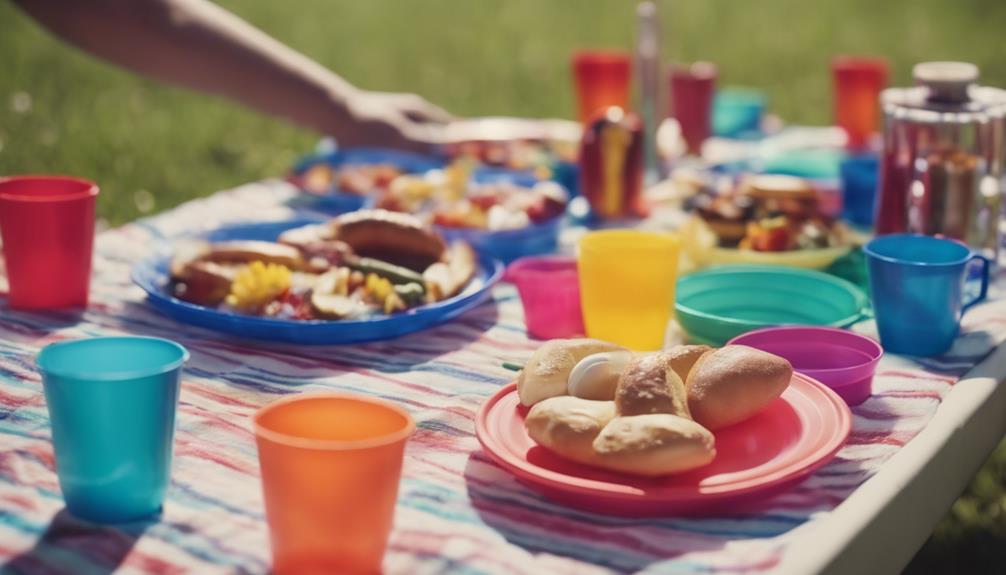
When choosing tableware, prioritize materials such as glass, ceramic, stainless steel, and bamboo for their safety and non-toxic properties. These materials offer a great alternative to plastic dinnerware, reducing plastic waste and potential health risks.
Glass and ceramic tableware aren't only stylish but also microwave-safe and free from harmful chemicals like BPA, phthalates, and melamine. Stainless steel tableware is a durable option that's long-lasting, resistant to corrosion, and easy to clean.
Bamboo tableware stands out as an eco-friendly choice, being biodegradable and sustainable for the environment. By opting for these safe materials, you can enjoy your meals without worrying about harmful substances leaching into your food. Make a conscious choice for your health and the environment by selecting tableware made from these safe and reliable materials.
Tips for Safe Use of Plastic Tableware

For safer use of plastic tableware, it's important to avoid microwaving them to prevent chemical leaching into your food. Follow these tips to guarantee the safe use of your plastic tableware:
- Handwash Carefully: Wash your plastic tableware by hand using a mild soap. Avoid using a dishwasher as the heat and harsh detergents can damage the plastic, leading to potential chemical leaching.
- Choose BPA-Free: Opt for plastic tableware that's labeled BPA-free and phthalate-free. This helps reduce your exposure to harmful chemicals that may be present in some plastics.
- Check for Safety Labels: Look for labels indicating that the plastic tableware is microwave-safe and dishwasher-safe. Following these guidelines ensures that you're using the tableware correctly.
- Replace Damaged Pieces: If your plastic tableware shows signs of wear or damage, it's best to replace them. Damaged tableware can harbor bacteria and contaminate your food, compromising your safety.
Choosing BPA-Free Tableware
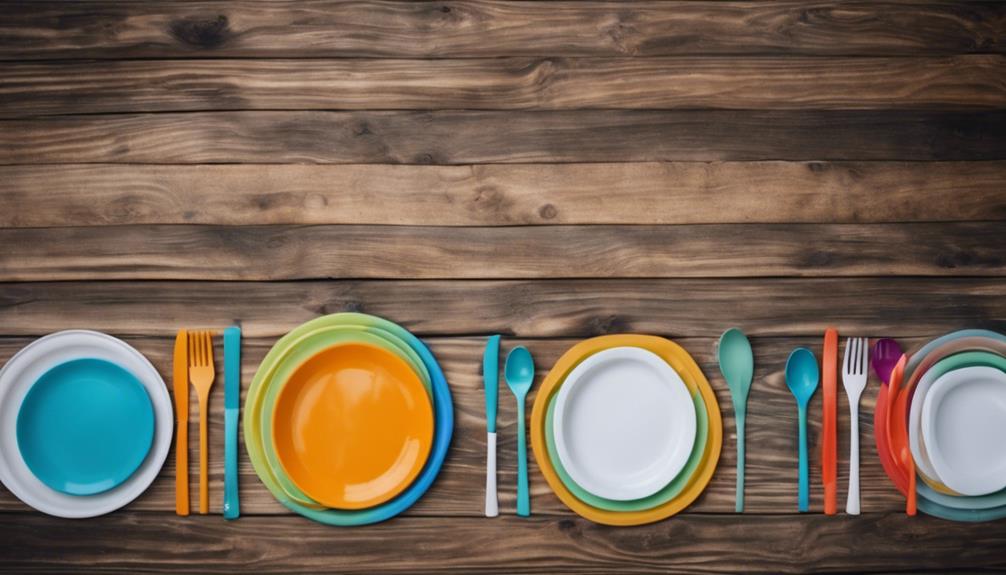
When selecting tableware, opt for items labeled as BPA-free to reduce potential health risks associated with this chemical.
Choosing BPA-free options like glass, stainless steel, or specific plastics can provide safer alternatives for serving and storing food.
Make informed decisions to minimize exposure to harmful chemicals in your everyday meals and beverages.
BPA-Free Benefits
Selecting BPA-free tableware is an essential step in protecting your health from potential risks associated with harmful chemicals like BPA. When choosing BPA-free options, you benefit from:
- Reduced Exposure: Minimize the risk of BPA leaching into your food.
- Health Protection: Avoid potential health issues linked to BPA, such as hormone disruption.
- Safety Assurance: Opt for tableware that reduces the chance of developmental problems.
- Wide Availability: Easily find BPA-free tableware in the market for a safer dining experience.
Opting for BPA-free tableware provides peace of mind, ensuring you can enjoy your meals without worrying about chemical exposure from plastic products.
Safe Alternatives
To safeguard your safety and health, prioritize choosing BPA-free tableware when selecting dining options. BPA-free materials are crucial to avoid exposure to harmful industrial chemicals. Look for labels indicating BPA-free materials to guarantee non-toxicity and reduce the risk of chemical leaching into your food or drinks.
BPA has been associated with various health risks, highlighting the importance of opting for safe alternatives. Consider using materials such as glass, ceramic, stainless steel, or melamine-free options as safer alternatives to replace BPA-containing tableware.
Ensuring Safety of Microwave-Safe Tableware
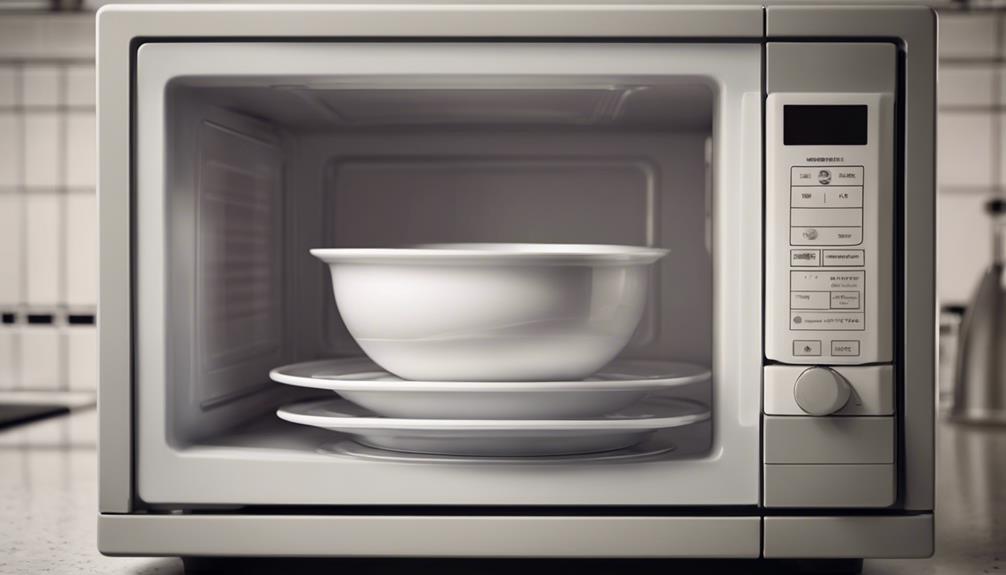
To guarantee the safety of microwave-safe tableware, always check for the designated label indicating its suitability for microwave heating. When using microwave-safe tableware, keep these tips in mind:
- Check for the Label: Look for tableware specifically labeled as microwave-safe to confirm it can withstand the heat.
- Use Suitable Materials: Opt for tableware made of materials like polypropylene or polyethylene, commonly used for microwave-safe products.
- Avoid Overheating: Prevent damage and potential chemical leaching by not overheating food on microwave-safe tableware.
- Follow Manufacturer Guidelines: Refer to the manufacturer's instructions for recommended heating times and guidelines to maintain the safety of the tableware.
Frequently Asked Questions
Is It Unhealthy to Eat With Plastic Utensils?
Eating with plastic utensils can be unhealthy due to potential exposure to harmful chemicals like BPA and phthalates. High temperatures can cause these chemicals to leach into your food, posing health risks.
Opting for safer alternatives like stainless steel or bamboo utensils can reduce your exposure to these harmful substances. It's best to avoid heating food with plastic utensils and choose non-toxic options for better overall health.
Is It Unhealthy to Eat in Plastic Plates?
Warm or hot food on plastic plates can absorb harmful chemicals, like polystyrene and melamine, posing health risks. Long-term exposure to these chemicals can lead to adverse health effects.
High levels of harmful chemicals can be detected in urine after consuming food from plastic plates. This absorption contributes to environmental pollution, especially in oceans.
Be cautious when using plastic tableware to avoid potential health hazards and environmental damage.
What Are the Side Effects of Plastic Plates?
Using plastic plates can have detrimental effects on your health and the environment. Harmful chemicals like melamine and polystyrene can leach into your food, leading to kidney problems, hormonal imbalances, and potential carcinogenic risks.
Microplastics from plastic plates can contaminate your food and beverages, posing health risks. Additionally, plastic plates contribute to environmental pollution and waste build-up, impacting ecosystems and marine life.
Consider safer alternatives for your health and the planet.
Is BPA in Plastic Plates?
Yes, BPA is present in some plastic plates. This chemical can pose health risks like hormone disruption when it leaches into food or drinks, especially when exposed to heat.
To reduce exposure, opt for BPA-free plastic plates. Manufacturers now offer safer alternatives to address these concerns. Check labels to make sure you choose BPA-free options and minimize potential health risks associated with this chemical.
Conclusion
So, next time you reach for that plastic tableware, just remember – it may not be as safe as you think. Despite the convenience, harmful chemicals can leach into your food, posing potential risks to your health.
Maybe it's time to reconsider your options and opt for safer materials like glass or stainless steel. Your health is worth the extra effort, after all.
